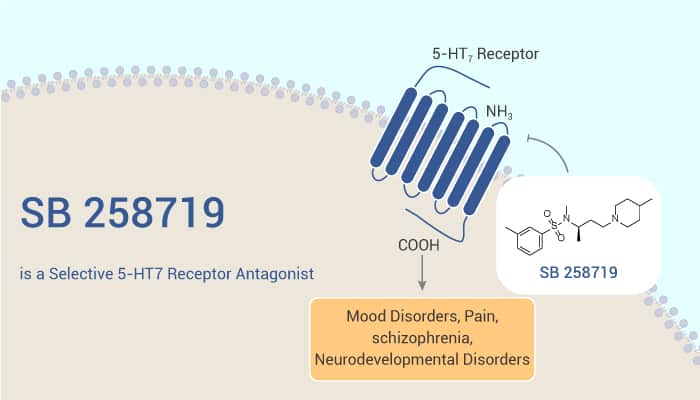The neurotransmitter 5-hydroxytryptamine (5-HT) has an array of pharmacological and physiological roles within the central nervous system. It has the potential to develop a number of useful medicines. The selective 5-hydroxytryptamine (5-HT, serotonin) reuptake inhibitors (SSRIs) show potency in major depression. 5-HT receptors divide into seven major classes (5-HT1-7). The 5-HT7 receptor is positively coupled to adenylyl cyclase via Gs-proteins. In addition, the amygdala, cortex, hippocampus, thalamus, septum, hypothalamus, and suprachiasmatic nucleus had found 5-HT7 receptor mRNA. Thus, there appears to be a good correlation between the protein and mRNA distribution. In the CNS, the 5-HT7 receptor plays a role in depression. In addition, receptor 5-HT7 has higher expression in the two primary cell lines (HepG2 and HuH-7). It also reduces expression in the remaining cell lines compared to MIHA. SB 258719 is a selective 5-HT7 receptor antagonist with high affinity (pKi=7.5).

SB 258719 is a selective 5-HT7 receptor antagonist. It has 100-fold selectivity over a range of other receptors including 5-HT1A pKi<5.1, 5-HT2A<4.8, 5-HT2C<4.8. SB 258719 also reduces the cell viability of serum-deprived HuH-7 and HepG2 cells. Moreover, SB 258719 reduces the proliferation of HuH-7 and HepG2 cells and also down-regulates β-catenin. Furthermore, it attenuates the growth of patient-derived primary HCC cultures in the presence of 5-HT and cell viability. SB 258719 down-regulates the expression of β-catenin in patient-derived primary HCC cultures. SB-258719 also reduced tumor growth in vivo. It also (1-30 mg/kg; i.p.) reverses the hypothermic effect of 5-CT in mice. In addition, the effect of 5-CT on body temperature was examined on 5-HT7 receptor null mutant mice.
In summary, SB 258719 is a selective 5-HT7 receptor antagonist with high affinity. SB 258719 has the potential for the research of cancer and neurological disease.
Reference:
Guscott MR, et al. Neuropharmacology. 2003;44(8):1031-1037.;Fatima S, et al. Mol Oncol. 2016;10(2):195-212.